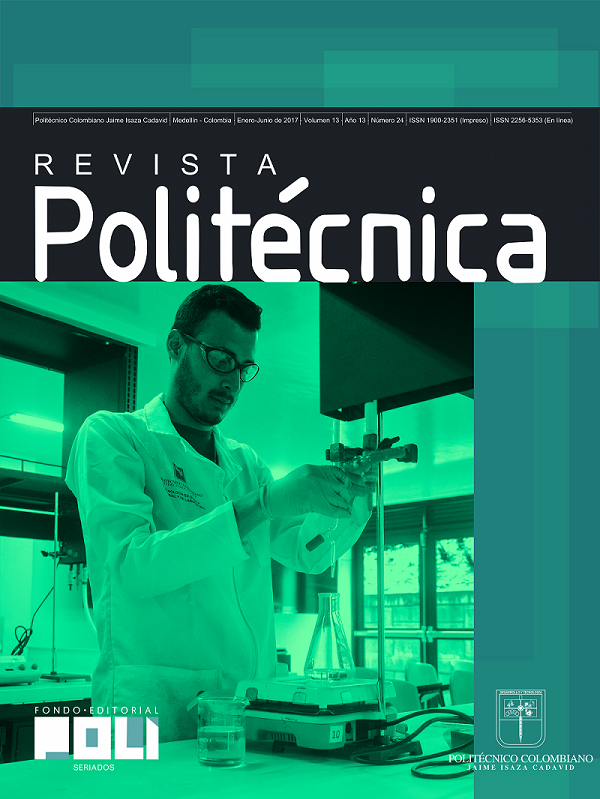Compliant mechanisms: from the conceptual design to their manufacture
Keywords:
Compliant mechanisms, systematic design, structuraloptimization, topology optimization method (TOM), finite element method (FEM)Abstract
The compliant mechanisms (CMs) are monolithic structures where the displacement is given by the flexibility of their structural members. Thus, the CMs show certain advantages compared with their counterparts, the rigid bodies; since assembling or lubrication are not required. This paper presents a systematic methodology to produce a gripper-type CM, from the design to their manufacture. For designing the CM, the topology optimization method (TOM) is used, where optimal structures are automatically designed by distributing a given amount of material within a specified design domain seeking for maximizing the displacement at a point. Next, a series of operations are applied to the TOM design for reducing the geometry complexity and then manufacturing costs. With the proposed methodology, an optimal and functional CM with innovative geometry is obtained.
Article Metrics
Abstract: 1761 HTML (Español (España)): 1099 PDF (Español (España)): 551 XML (Español (España)): 39References
Kota, S., Compliant systems using monolithic mechanisms, Smart Mater. Bull., 3, 7–10, 2001.
Howell, L.L., Magleby, S. P. y Olsen, B. M., Handbook of compliant mechanisms, John Wiley & Sons, United Kingdom, 2013.
Gad-el-Hak, M., The MEMS handbook, 2a ed. Taylor & Francis, Boca Raton, FL., 2006.
Vogel, S., Cats’ paws and catapults: mechanical worlds of nature and people. WW Norton & Co., New York, 1998.
Ramírez-Gil, F.J., Diseño óptimo de micromecanismos tridimensionales con actuación electrotérmica utilizando optimización topológica y unidades de procesamiento gráfico (GPU) [Tesis de maestría], Medellín, Colombia, Universidad Nacional de Colombia, 2013.
Sepúlveda-Orozco, E. Diseño de un colector de energía piezoeléctrico (energy harvesting) mediante optimización topológica que maximice la transformación de energía mecánica en eléctrica generada por un ser humano al caminar”, [Tesis de maestría], Medellín, Colombia, Universidad Nacional de Colombia, 2015.
Lobontiu, N., Compliant mechanisms: design of flexure hinges, CRC Press, Boca Raton, 2003.
Smith, S.T., Flexures: elements of elastic mechanisms, Gordon & Breach, Amsterdam, 2000.
Bendsøe, M.P. y Sigmund, O., Topology optimization: theory, methods, and applications, Springer, 2a Ed., Berlin, 2003.
Pahl, G., Beitz, W., Feldhusen, J. y Grote, K.H., Engineering design: a systematic approach, Springer, London, 2007.
Ma, Z.D., Wang, H., Kikuchi, N., Pierre, C. y Raju, B. Experimental validation and prototyping of optimum designs obtained from topology optimization, Struct. Multidiscip. Optim., 31, (5), 333–343, 2006.
Cross, N., Engineering design methods: strategies for product design, Wiley, New York, 2000.
Narváez, C.A. y Garzón-Alvarado, D.A., Síntesis topológica de mecanismos flexibles para aplicaciones biomédicas, Rev. Cuba. Investig. Bioméd., 29 (1), 1–16, 2010.
Napieralski, A., Napieralska, M., Szermer, M. y Maj, C., The evolution of MEMS and modelling methodologies, Int. J. Comput. Math. Electr. Electron. Eng., 31 (5), 1458–1469, 2012.
Deepak, S.R., Dinesh, M., Sahu, D.K. y Ananthasuresh, G.K., A comparative study of the formulations and benchmark problems for the topology optimization of compliant mechanisms, J. Mech. Robot., 1(1), 1–8, 2008.
Howell, L. y Midha, A., Parametric deflection approximations for initially curved, large-deflection beams in compliant mechanisms, en ASME Design Engineering Technical Conferences, Irvine, California, USA, 1996.
Ananthaturesh, G.K., Kota, S. y Gianchandani, Y., A methodical approach to the synthesis of compliant micromechanisms. En: V IEEE Solid-State Sensors and Actuators Workshop, Hilton Head Island, SC, USA, 189–192,1994.
Bendsøe, M. y Sigmund, O., Material interpolation schemes in topology optimization, Arch. Appl. Mech., 69 (9), 635–654, 1999.
Cardoso, E.L. y Fonseca, J.S.O., Complexity control in the topology optimization of continuum structures, J. Braz. Soc. Mech. Sci. Eng., 25 (3), 293–301, 2003.
Sigmund O. y Petersson, J., Numerical instabilities in topology optimization: A survey on procedures dealing with checkerboards, mesh-dependencies and local minima, Struct. Optim., 16 (1), 68–75, 1998.
Zhang, Y., Solving large-scale linear programs by interior-point methods under the Matlab environment, Optim. Methods Softw., 10 (1), 1–31, 1998.
Haftka, R.T. y Gürdal, Z., Elements of structural optimization, Springer, 3a ed., 1992.
Ramírez, F., Sepúlveda, E. y Montealegre, W., Diseño de mecanismos flexibles mediante el método de optimización topológica. En: Métodos numéricos y sus aplicaciones en diferentes áreas, Cali, Colombia, UAO, 545–552, Agosto, 2013.
Tovar, A., Optimización topológica con la técnica de los autómatas celulares híbridos, Rev. Int. Métod. Numér. Para Cálculo Diseño En Ing., 21 (4), 365–383, 2005.
Sigmund, O., On the design of compliant mechanisms using topology optimization, Mech. Struct. Mach., 25 (4), 493–524, 1997.
Vatanabe, S.L., Montealagre, W. y Silva, E.C.N., Modeling of functionally graded materials. En: Comprehensive materials processing, Elsevier, 261–282, 2014.
Gibson, I., Rosen, D. y Stucker, B., Additive manufacturing technologies: 3D printing, rapid prototyping, and direct digital manufacturing, Springer, New York, 2015.
Stratasys Ltd, How FDM 3D Printing Works. Disponible en: http://www.stratasys.com/3d-printers/technologies/fdm-technology. [Consultado el 07-sep-2016].
Sigmund, O., A 99 line topology optimization code written in Matlab, Struct. Multidiscip. Optim., 21 (2), 120–127, 2001.
Méndez-Algarra, G.A. y Tovar, A., Integrating topology and shape optimization: a way to reduce weight in structural ship design, Ship Sci. Technol., 3 (5), 83–92, 2009.


 _
_


















